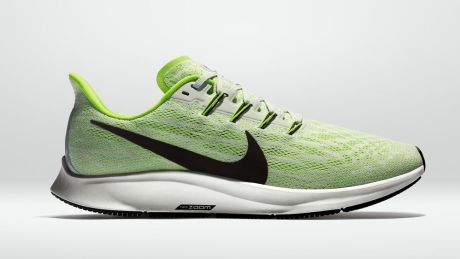You can trust Coach
One of the reasons the Pegasus has been such a popular running shoe for such a long time – we’re now over halfway through the fourth decade of annual updates to the line – is that Nike doesn’t tend to do an awful lot with each new release. After all, why overhaul a shoe that’s proved so popular?
Evolution rather than revolution remains very much the order of the day with the 36th edition of the Pegasus, the only noticeable changes to the shoe being in the upper and tongue. They’re good changes – the overly long and padded tongue on the 35 was not comfortable, so the smaller tongue here is welcome – but they’re minor changes all the same.
Underfoot, the Pegasus 36 offers the same Zoom Air cushioning as its predecessor, and the ride is firm but still fairly cushioned, right in the Goldilocks zone for a running shoe. The Pegasus 36 is suitable for a wide variety of training and racing, and if you’re new to running and have no idea what you like in a shoe, it’s a solid pick that’s unlikely to disappoint.
See related
- Nike’s Updated Zoom Series Contains Its Fastest Running Shoes
- The Best Nike Running Shoes For Every Type Of Runner
- The Best Running Shoes

For a long time, however, the Pegasus was more than that – it was the best all-rounder shoe out there. That’s no longer the case, partly because of Nike’s conservative approach in updating the shoe.
There are now lighter, faster and more comfortable all-round running shoes, and the best of them all is made by Nike itself. The Pegasus Turbo uses a mix of Nike’s React and ZoomX foams in the midsole to provide and softer, bouncier ride than the standard Pegasus, and it’s much lighter as well. Nike’s also releasing a second edition of the Turbo on 11th July.
The Pegasus Turbo is more expensive than the Pegasus at £159.95 compared with £104.95, but other brands do offer all-round running shoes that I rate higher than the 36 at nearer the £100 mark. The Saucony Ride ISO 2 is £120 and has a livelier ride than the 36, and the Brooks Launch 6 is lighter, faster and £95.
Like the 35, I found the Pegasus 36 struggled at faster paces. On tempo runs and during strides the shoe was a little clumsy and lacking the responsiveness of the Pegasus Turbo or Ride ISO 2. I’ve probably been spoilt by the Pegasus Turbo, which is also softer and more fun to use for easy runs.
All the positive features of a Pegasus shoe are present in the 36. It’s reasonably cheap, works for all kinds of running, looks good, and seems as durable as its predecessors. It is, however, just not as fun or fast to run in as other all-round shoes that use more responsive midsoles. It will probably remain as popular as ever partly because it hasn’t really changed much from the predecessor but given the innovation going on elsewhere in running shoes, much of which is spearheaded by Nike, the Pegasus is just a little, well, boring.
Buy mens from Nike | Buy women’s from Nike | £104.95

Nick Harris-Fry is a journalist who has been covering health and fitness since 2015. Nick is an avid runner, covering 70-110km a week, which gives him ample opportunity to test a wide range of running shoes and running gear. He is also the chief tester for fitness trackers and running watches, treadmills and exercise bikes, and workout headphones.

